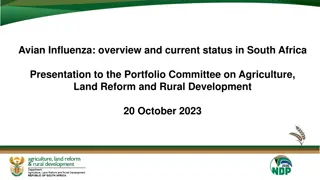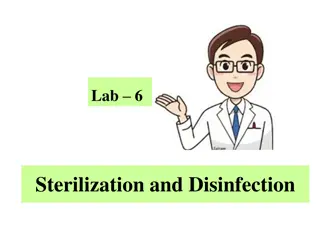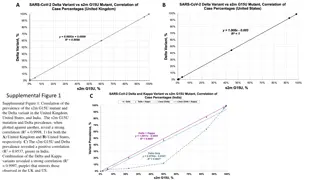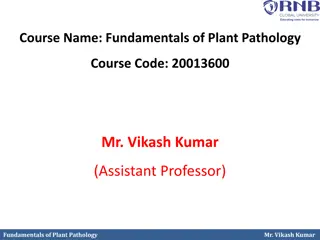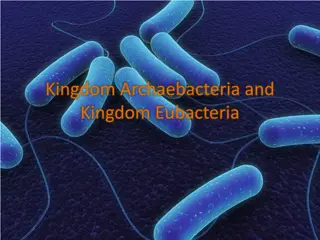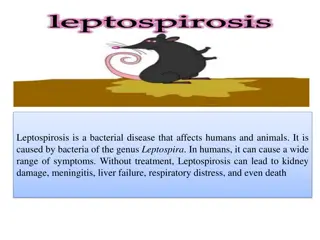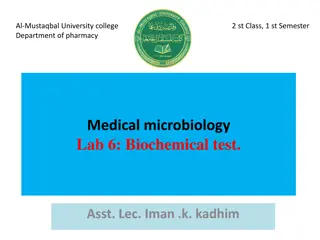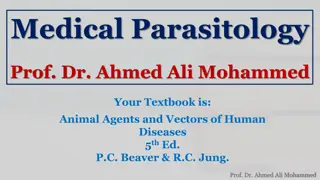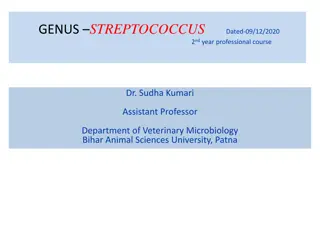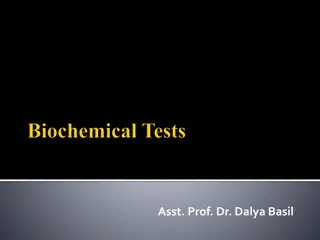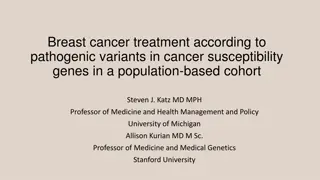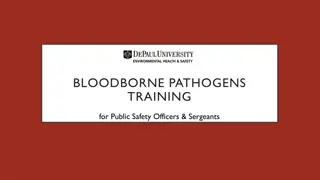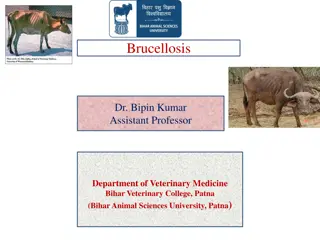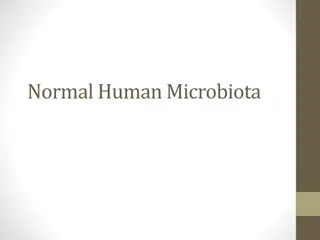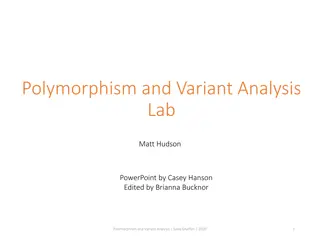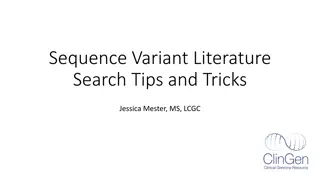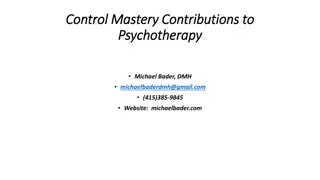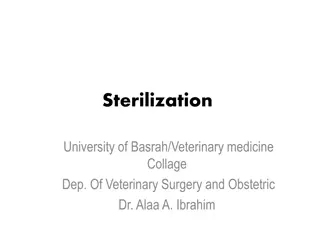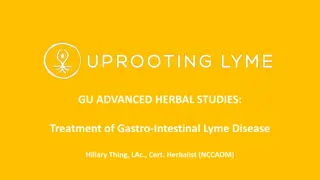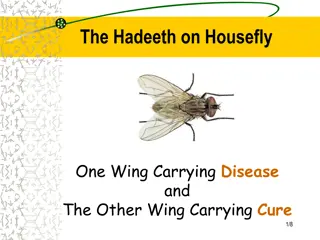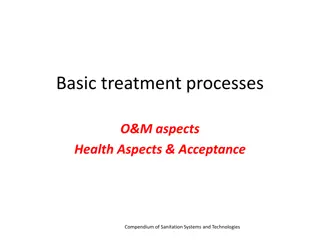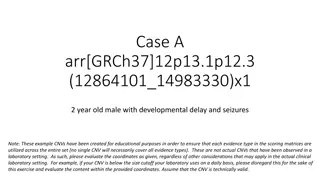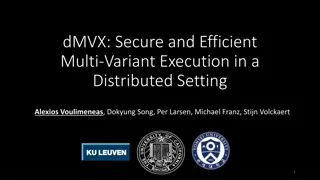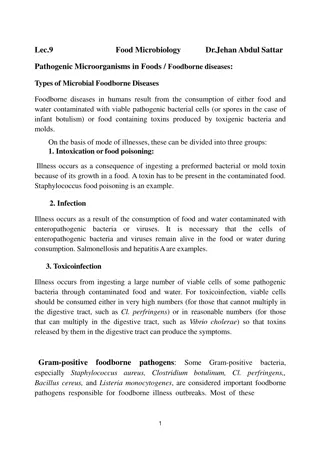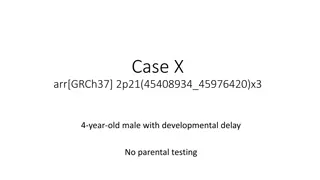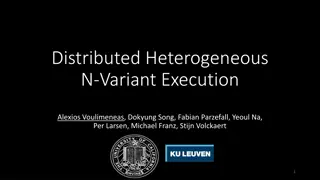Impact of Highly Pathogenic Avian Influenza 2023 on South African Broiler Industry
The presentation by the South African Poultry Association sheds light on the detrimental effects of Highly Pathogenic Avian Influenza (HPAI) on the broiler industry in South Africa. Factors such as load shedding, water supply interruptions, and now, the outbreak of H7N6, have exacerbated the financi
4 views • 19 slides
Avian Influenza Overview and Outbreak History in South Africa
Avian Influenza, specifically Highly Pathogenic Avian Influenza (HPAI) outbreaks in South Africa, have been documented since 2004, affecting primarily ostriches and poultry. Wild bird transmission remains a concern, with risk factors such as rainfall, temperature, wetlands, and poultry movements con
2 views • 25 slides
Understanding Sterilization and Disinfection Methods in Laboratory Settings
Sterilization involves killing all microorganisms while disinfection targets pathogenic ones. Various methods like heat, filtration, radiation, and chemicals are used for effective sterilization. Physical sterilization through heat includes dry heat, direct flaming, hot air ovens, and incineration.
4 views • 21 slides
Correlation of s2m G15U Mutant and Delta Variant Prevalence
The correlation between the prevalence of the s2m G15U mutant and the Delta variant in the UK, US, and India was analyzed, showing strong correlations in the UK and US, and a positive correlation in India. Analysis of the s2m phenotype in the Alpha, Delta, and Kappa variants was also conducted. Addi
3 views • 4 slides
Fundamentals of Plant Pathology with Mr. Vikash Kumar - Course Overview and Important Pathogens
This course with Mr. Vikash Kumar covers the fundamentals of plant pathology, including identification of diseases, pathogen nature, disease management strategies, and principles. Learn about important plant pathogenic organisms such as fungi, bacteria, and fastidious vascular bacteria, along with s
0 views • 12 slides
Contrasting Kingdoms: Archaebacteria vs Eubacteria
Archaebacteria and Eubacteria are two distinct kingdoms of bacteria with unique characteristics. Archaebacteria, originating from Ancient Greek, are ancient organisms thriving in extreme conditions without peptidoglycan in their cell walls, while Eubacteria, the most common bacteria, have peptidogly
0 views • 11 slides
Understanding Leptospirosis: Causes, Symptoms, and Epidemiology
Leptospirosis is a bacterial disease affecting humans and animals caused by the Leptospira genus. Symptoms range from kidney damage to death if untreated. The disease has various synonyms and is caused by pathogenic leptospires. It is prevalent in both animals and humans globally, with various serov
1 views • 26 slides
Microbiology Lab Tests for Identifying Bacterial Pathogens
Learn about key biochemical tests like the Coagulase Test, Catalase Test, and Oxidase Test used in medical microbiology to identify pathogenic bacteria such as Staphylococcus aureus. Understand the methods, significance, and interpretation of results for each test.
4 views • 17 slides
Understanding Food and Water-Borne Diseases: Causes and Classification
Food and water-borne diseases, caused by contaminated food or water, lead to acute illnesses. These diseases are classified into food-borne infections and food-borne intoxications. Food-borne infections, triggered by pathogenic microorganisms, can be fungal, bacterial, viral, or parasitic, with long
3 views • 57 slides
Understanding Parasitism in Medical Parasitology by Prof. Dr. Ahmed Ali Mohammed
Prof. Dr. Ahmed Ali Mohammed delves into the intriguing world of parasitism, exploring the complex relationships between parasites and hosts. He explains the various types of relationships in parasitology, such as symbiosis, mutualism, commensalism, and parasitism, shedding light on how parasites in
0 views • 23 slides
Overview of Streptococcus Bacteria and Classification
Streptococcus is a genus of gram-positive bacteria commonly found on skin and mucous membranes. It includes pathogenic and non-pathogenic species, with cell division along a single axis forming pairs or chains. The bacteria were first observed by Billroth and named by Ogston. Different types of stre
0 views • 28 slides
Understanding Coagulase Test in Microbiology
The Coagulase test is a crucial microbiological method used to differentiate Staphylococcus aureus (Coagulase Positive) from other Staphylococci (Coagulase Negative). By detecting the presence of the enzyme coagulase, this test helps identify pathogenic strains of Staphylococcus that can cause serio
2 views • 28 slides
Breast Cancer Genetic Variants and Treatment Guidelines
Recent research highlights the importance of genetic testing for cancer susceptibility genes in breast cancer patients to guide personalized treatment plans. Guidelines based on pathogenic variants in genes like BRCA1, BRCA2, and others provide insights on relative cancer risks and recommendations f
0 views • 21 slides
Understanding Salmonella: A Zoonotic Pathogen
Salmonella, a genus of bacteria, includes species causing various diseases in humans, cattle, sheep, goats, and poultry. The pathogen can be transmitted through contaminated food and is classified into typhoidal and nontyphoidal serovars. Nontyphoidal serovars are common and typically lead to self-l
0 views • 20 slides
Bloodborne Pathogens Training for Public Safety Officers & Sergeants
Bloodborne pathogens (BBPs) are pathogenic microorganisms found in human blood that can cause diseases like HIV, Hepatitis B, and Hepatitis C. Public safety officers and sergeants face occupational exposure to BBPs and should follow OSHA's BBP Standard to protect themselves. Training, vaccinations,
0 views • 41 slides
Understanding Brucellosis: A Zoonotic Disease Impacting Animals and Humans
Brucellosis, caused by the genus Brucella, is a zoonotic disease affecting animals like goats, sheep, cattle, and humans. It is primarily transmitted through contact with infected animals or ingestion of their products. The disease manifests in various forms like Mediterranean fever and can lead to
0 views • 13 slides
Understanding Coagulase Test in Microbiology
Coagulase test is a crucial microbiological technique used to differentiate Staphylococcus aureus, which produces coagulase, from other species like S. epidermis and S. saprophyticus that do not. This test helps in identifying the presence of bound and free forms of coagulase, aiding in the accurate
0 views • 56 slides
Understanding the Genus Neisseria: Pathogens and Characteristics
The genus Neisseria comprises important pathogens such as Neisseria meningitidis and Neisseria gonorrhoeae, causing meningitis, gonorrhea, and other infections. This article explores their characteristics, differentiation from non-pathogenic species, properties like Gram-negative diplococci, and ser
0 views • 32 slides
Understanding Normal Human Microbiota and Its Role in Health
Normal human microbiota refers to the microorganisms residing on our skin and mucous membranes, playing vital roles in digestion, immunity, and protection against pathogens. They are categorized into resident and transient groups, with resident flora aiding in maintaining health by synthesizing nutr
0 views • 28 slides
Understanding Plant Pathology: Importance, Scope, and Objectives
Plant pathology, also known as phytopathology, is the study of plant diseases and their management. It covers the causes, symptoms, and impact of pathogenic organisms on plants. The field aims to understand the interactions between plants and pathogens, develop control methods, and reduce losses in
0 views • 6 slides
Polymorphism and Variant Analysis Lab Exercise Overview
This document outlines a lab exercise on polymorphism and variant analysis, covering tasks such as running Quality Control analysis, Genome Wide Association Test (GWAS), and variant calling. Participants will gain familiarity with PLINK toolkit and explore genotype data of two ethnic groups. Instruc
0 views • 43 slides
Enhancing Literature Search for Sequence Variant Analysis
Enhance your literature search skills for sequence variant analysis with tips on effective use of variant nomenclature, sources for finding articles for ACMG criteria application, and tools like HGMD, ClinVar, MasterMind, Google, and Google Scholar. Discover the importance of functional studies, cas
0 views • 21 slides
Understanding Foodborne Illness: Causes and Symptoms
Foodborne illnesses are diseases transmitted to humans through contaminated food, causing symptoms like nausea, vomiting, stomach cramps, fever, and diarrhea. These illnesses are mainly caused by pathogenic microorganisms such as bacteria, viruses, and parasites, often spread through mishandling of
0 views • 10 slides
BioCuration Variant Curation Guidelines and Recommendations
BioCuration Working Group's variant curation guidelines by Steven Harrison provide critical flexibility in variant classification, allowing criteria weights to be adjusted based on professional judgment. Recommendations include harmonizing ACMG/AMP guidelines and documenting strength-modified eviden
3 views • 42 slides
Understanding Survivor Guilt, Imposter Syndrome, and Testing in Therapy
Survivor guilt, first identified in Holocaust survivors, can manifest as feeling undeserving of success. Imposter syndrome involves feeling fraudulent in one's success and fearing exposure. Passive into active testing in therapy allows patients to work through pathogenic beliefs by enacting them wit
2 views • 10 slides
Guidelines on Sterilization, Disinfection, and Types of Disinfectants in Veterinary Medicine
Sterilization is the process of eliminating all microorganisms from an object, while disinfection reduces the number of pathogenic microorganisms on surfaces. Various types of disinfectants exist, including high-level, intermediate-level, and low-level options. Different equipment items in veterinar
0 views • 18 slides
Advanced Herbal Approaches for Gastro-Intestinal Lyme Disease Treatment
Unveil the symptoms, stealth pathogenic gut infections, differentiation from typical GI diseases, causes of GI disorders, and post-natal Qi tonification in addressing Gastrointestinal Lyme Disease using advanced herbal studies. Learn to differentiate infectious GI diseases, identify potential causes
0 views • 38 slides
Scientific Study on Houseflies and Disease Prevention
Prophet Muhammad's teaching on houseflies carrying both disease and cure sparked a scientific study led by a student research team at Qassim University. The study demonstrated that submerging houseflies in water can inhibit the growth of pathogenic bacteria, potentially leading to the extraction of
0 views • 8 slides
Understanding Tuberculosis: A Comprehensive Overview of the Disease
Tuberculosis, a chronic disease affecting both humans and animals, is caused by pathogenic Mycobacterium spp. This article covers the etiology, synonyms, history, and geographic distribution of tuberculosis, along with key terms like anthropozoonosis and zooanthroponosis. Learn about the tubercle ba
0 views • 24 slides
Understanding Export Controls at UW-Madison
Export controls at UW-Madison are U.S. laws regulating the export of information, goods, and services, including research activities involving foreign persons. Violations can lead to severe penalties. The laws may apply to scenarios like research with pathogenic materials, satellite research, and fo
2 views • 14 slides
Operation and Maintenance Aspects of Sanitation Systems
Maintenance of basic treatment processes, settlers, and anaerobic baffled reactors (ABR) is crucial for efficient functioning. Regular sludge removal, careful handling of pathogenic organisms, and monitoring scum levels are essential tasks. Anaerobic systems like ABR require a start-up period and sp
0 views • 32 slides
Comprehensive Assessment of a Pathogenic CNV in a 2-Year-Old Male with Developmental Delay and Seizures
In this case study, a 2-year-old male presenting with developmental delay and seizures was evaluated for a CNV at the 12p13.1p12.3 region. The CNV was found to overlap with the GRIN2B gene, a known haploinsufficient gene associated with developmental disorders. Despite potential additional scoring c
0 views • 17 slides
Overview of Amoebae: Parasitic and Free-Living Varieties
Various types of amoebae, including parasitic Entamoeba histolytica and harmless commensal amoebae, are discussed in terms of their morphology, epidemiology, pathogenesis, clinical presentation, diagnosis, treatment, and habitats, such as the large intestine and water sources. Pathogenic free-living
0 views • 9 slides
Effects of Spicy Foods on Pathogenic Microbial Growth: A Study on Rosemary and Clove
Spicy foods like rosemary and clove have shown potential in inhibiting pathogenic microbial growth, which can help enhance food safety by reducing the need for chemical additives. This study explores the antimicrobial effects of these spices using microbial strains like Pseudomonas Fluorescens and S
0 views • 14 slides
Understanding Avian Influenza: Symptoms, Diagnosis, and Prevention
Avian influenza, or bird flu, is a viral disease affecting birds' respiratory, digestive, and nervous systems. It presents in two forms - Highly Pathogenic Avian Influenza Virus (HPAIV) and Low Pathogenic Avian Influenza Virus (LPAIV). The virus has two important surface antigens, Hemagglutinin (H)
0 views • 7 slides
Secure and Efficient Multi-Variant Execution in Distributed Settings
This paper discusses dMVX, a system for secure multi-variant execution in distributed settings to mitigate memory errors and protect against attacks. Using leader and follower variants, diversified program variants run in lockstep to ensure security. The system monitors and replicates I/O results, e
0 views • 35 slides
Understanding Foodborne Diseases and Pathogenic Microorganisms in Foods
Foodborne diseases in humans are caused by consuming contaminated food or water containing pathogenic microorganisms or toxins. These diseases can be categorized into intoxication, infection, and toxicoinfection, each with distinct modes of illness. Pathogens like Staphylococcus aureus, Clostridium
0 views • 5 slides
Case Study: 2p21 Duplication in a 4-Year-Old Male with Developmental Delay
This case study involves a 4-year-old male with developmental delay and a duplication in the 2p21 region. The genetic analysis indicates no parental testing has been done, and the duplication has been reported as LP/VUS (Likely Pathogenic / Variant of Uncertain Significance). Predicted genes and int
0 views • 16 slides
N-Variant Execution for Improved Security Measures
N-Variant Execution (NVX) is a technique used to enhance security measures by running diversified program variants in parallel and comparing their outputs for transparency. NVX systems can protect against attacks relying on knowledge of virtual address spaces but have limitations against attacks bas
0 views • 48 slides
Identification and Characterization of SVA Retroelement Insertions in Hereditary Cancer Panels
SVA retroelement insertions, specifically SINE-VNTR-ALU (SVA) types, were examined through Next Generation Sequencing (NGS) and RNA analysis in hereditary cancer panel testing. Twelve unique SVA retroelements were identified in genes like APC, BRCA1, CHEK2, and others, with variant interpretations r
0 views • 6 slides

